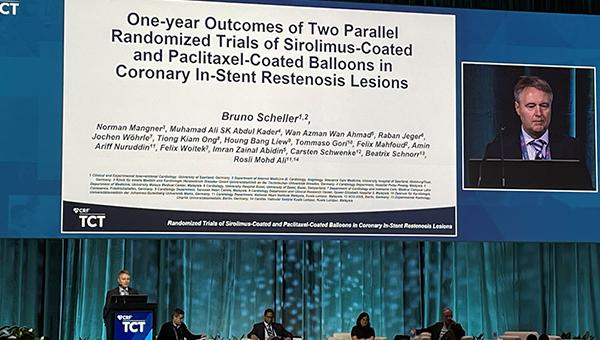DCBs in Coronaries? Some Good News, but More Work Needed
Sirolimus and biolimus have potential, but their ultimate standing in comparison to paclitaxel is unclear at best, experts say.

Three presentations at TCT 2021 show the promise for use of drug-coated balloons (DCB) in coronary arteries ranging from the treatment of new lesions, to in-stent restenosis and small coronaries. At the same time, it’s clear that caution is warranted around the choice of drug, the durability, and the significance of late lumen enlargement.
While European interventionalists have had DCB-based technology in their toolboxes for years, the United States has no fully approved dedicated DCBs for coronary use. A few devices, including Selution SLR (MedAlliance), SeQuent Please ReX (B. Braun), Virtue (Orchestra BioMed), Agent DCB (Boston Scientific), and Magic Touch (Concept Medical) have been granted breakthrough device designation (allowing for fast-tracked review) by the US Food and Drug Administration.
“As US interventionalists, we are all clawing and begging for drug-coated balloons, but we want them to be safe and we want them to be effective,” Roxana Mehran, MD (Icahn School of Medicine at Mount Sinai, New York, NY), told TCTMD. “The safety and efficacy data on the coronary side, with what we saw evaluated today, is absolutely not there for what FDA needs.”
Mehran, who moderated a press conference prior to the three presentations, said late lumen loss and mechanistic data are fine, but long-term outcomes are what is really needed to move the needle forward if coronary DCBs are going to be a real option for American interventionalists. Despite their availability in Europe, she said, “we're not seeing sponsors working to show safety and efficacy data in larger numbers of patients like we have done with stenting.”
Paclitaxel is the standard for most of the coronary DCBs in Europe. That adds another layer of problems due to the issues raised in a 2018 meta-analysis over a potential mortality signal with paclitaxel-based DCBs and stents in peripheral interventions.
“I think the controversy has made everyone stop and think, and obviously, it's slowed the [research] process a little,” Mehran noted. “But at the same time, it's opened doors for other technologies like sirolimus and biolimus.”
Pushing Forward With Alternative Drugs
In the first RCT, presented by Wan Azman Wan Ahmad, MD (University Malaya Medical Center, Kuala Lumpur), the sirolimus-coated SeQuent SCB (B. Braun) was compared against the paclitaxel-coated SeQuent Please Neo (B. Braun) in 70 patients with coronary de novo lesions who were treated at one of six centers in Malaysia.
The primary endpoint of late lumen loss at 6 months was 0.10 ± 0.32 mm in the sirolimus group and 0.01 ± 0.33 mm in the paclitaxel group. However, late lumen enlargement at 6 months occurred more commonly in lesions treated with paclitaxel than with sirolimus (58% vs 32%; P = 0.019).
Although not powered for clinical outcomes, at 12-month follow-up, there was no difference between treatment groups in terms of TLR, stent thrombosis, death, target-vessel MI, unscheduled angiography, or MACE (cardiac death, target-vessel MI, or clinically driven TLR).
Asked by TCTMD if he thought the late lumen enlargement was a true difference related to sirolimus, a play of chance, or something else, Wan Ahmad said he believes the finding is significant and requires more investigation as to why it occurred.
“I do think this is a key question,” added Mehran. “Is it real? Is sirolimus better than paclitaxel or vice versa, and does it matter?”
Commenting in the press conference, Luigi Salemme, MD (Montevergine Clinic, Naples, Italy), said one thing that is clear is that paclitaxel and sirolimus DCB comparisons can’t be viewed in the same light as comparisons of paclitaxel and sirolimus stents. “We need more data, of course, we need to treat more lesions, and we have to consider different lesions,” he noted.
Small Vessels and In-Stent Restenosis
Next up, the first-in-human BIO-RISE CHINA study showed that a biolimus-coated balloon was superior to plain old balloon angioplasty (POBA) in patients with small-vessel CAD for the primary endpoint of in-segment late lumen loss at 9 months. This study also was not powered for clinical outcomes.
Presenter Kai Xu, MD (General Hospital of Northern Theater Command, Liaoning, China), showed that late lumen loss was 0.17 ± 0.32 mm in the biolimus group and 0.29 ± 0.35 mm in the POBA group (P = 0.0034). As for late lumen enlargement, the rate was three times higher with biolimus than POBA at 29.7% vs 9.7% (P = 0.0007).
While Salemme said any comparisons with POBA are “useless” because of the proven efficacy of available DCBs, Mehran said it was important for the investigators to show safety and efficacy with the novel biolimus agent, “especially given everything that we've been through with paclitaxel.”
In the third presentation, Bruno Scheller, MD (Saarland University, Homburg/Saar, Germany), presented data from two RCTs of DCBs for in-stent restenosis: FIM Malaysian and German-Swiss, which compared the same DCBs as the trial from Wan Ahmad. The FIM Malaysian and German-Swiss RCTs were conducted in parallel using an identical study protocol.
For the primary noninferiority endpoint of angiographic late lumen loss at 6 months, both groups were similar, with the same in-lesion rate of 0.30 mm (difference 0; 95% CI -0.24-0.24; threshold < 0.35). Similarly, in-segment late lumen loss was 0.26 mm for sirolimus and 0.25 mm for paclitaxel (difference -0.01; 95% CI -0.24-0.23; threshold < 0.35). This trial also was not powered to detect clinical differences.
Scheller concluded that for now, paclitaxel DCBs remain the standard of choice for in-stent restenosis lesions.
Following the presentations, session moderator Juan F. Granada, MD (Cardiovascular Research Foundation, New York, NY), said one overriding concern with sirolimus use in coronary interventions is the durability of its effect. “You can find paclitaxel in the artery for a long time, but sirolimus goes away very quickly,” he said, adding that potential late catch-up concerns can’t be overlooked.
“That's one of the unanswered questions [and] that that's my concern, too,” Scheller added. “The studies we have seen today are very promising,” he said, adding that follow-up is too short to address issues such as late catch-up.
“I congratulate the investigators for pushing this field forward because there are still some issues with drug-eluting stents,” said panelist Wayne Batchelor, MD (Inova Heart & Vascular Institute, Falls Church, VA). “They're very predictable, we've got excellent results, but when you look at very late stent thrombosis and neoatherosclerosis, there are some limitations. Furthermore, in young patients, especially treating long segments of the LAD, I'm always concerned about that ‘full metal jacket’ that compromises the ability for surgical conduits later. So, I think the field should be pushed forward.”
L.A. McKeown is a Senior Medical Journalist for TCTMD, the Section Editor of CV Team Forum, and Senior Medical…
Read Full BioSources
Ahmad WA. A randomized trial of sirolimus-coated versus paclitaxel-coated balloons in de novo coronary lesions. Presented at: TCT 2021. Orlando, FL. November 6, 2021.
Han Y. BIO-RISE China: a randomized trial of a biolimus-coated balloon versus POBA in small vessel coronary artery disease. Presented at: TCT 2021. Orlando, FL. November 6, 2021.
Scheller B. One-year outcomes of two parallel randomized trials of sirolimus-coated and paclitaxel-coated balloons in coronary in-stent restenosis lesions. Presented at: TCT 2021. Orlando, FL. November 6, 2021.
Disclosures
- Wan Ahmad and Han report no relevant conflicts of interest.
- Scheller reports consulting for and receiving honoraria/speaker’s bureau fees from B. Braun and Medtronic; and holding equity in InnoRa GmbH.





Comments